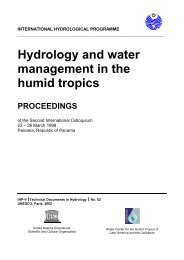FR AB - Science Reference
FR AB - Science Reference
FR AB - Science Reference
You also want an ePaper? Increase the reach of your titles
YUMPU automatically turns print PDFs into web optimized ePapers that Google loves.
BOOK REVIEWS<br />
Amino Acid Analysis Protocols. Edited by Catherine Cooper,<br />
Nicolle Packer, and Keith Williams. Methods in<br />
Molecular Biology series number 159.Totowa, NJ: Humana<br />
Press, September 2000. Hardcover, 280 pp, $84.50<br />
US.<br />
This volume is what the title states; it is intended<br />
as a benchtop reference that provides recipes and<br />
procedures for amino acid analysis. An introductory<br />
chapter by Margaret Tyler provides guidance to the<br />
topics found among the 17 other chapters of the<br />
book. Of these, several focus on standard amino acid<br />
analysis strategies commonly found in core facilities:<br />
postcolumn ninhydrin and AQC (AccuTag). The former,<br />
by Macchi and colleagues, is focused on modifications<br />
that occur (at low levels) during protein<br />
expression in a pharmaceutical setting. Here the ninhydrin<br />
system is well suited to resolving minor components<br />
(e.g., norleucine, hydroxylysine, amino sugars,<br />
and carboxmethylCys) amidst the high levels<br />
analyzed. One useful feature of this article is a clear<br />
illustration of typical (Excel) spreadsheet calculations<br />
employed to obtain protein amino acid compositions.<br />
The article on AQC by S. A. Cohen is clear and helpful,<br />
particularly in providing the buffer recipes for the<br />
analysis using Waters’ proprietary column. Shindo and<br />
colleagues describe an application of AQC analysis to<br />
identify blotted protein using the ExPASy Web Site.<br />
The authors correctly emphasize the need for good<br />
hygiene in sample handling and provide diagrams for<br />
an isolation box and their version of a hydrolysis<br />
vessel. In several places, the reader is reminded that<br />
desalting protein samples is important for accurate<br />
compositional analysis. To address this issue, there is<br />
a brief contribution from Zhang and Denslow that<br />
details simple desalting protocols.<br />
Phenylisothiocyanate (PITC) as detection reagent<br />
is discussed in comparison with new reagents and in<br />
the analysis of complex biologic matrices. Woo presents<br />
a comparison between butyl-isothiocyanate–<br />
(BITC-) and benzyl-isothiocyanate– (BZITC-) derivatized<br />
amino acids and the familiar PITC approach.<br />
Journal of Biomolecular Techniques<br />
11:177–178 © 2000 <strong>AB</strong>RF<br />
RF <strong>AB</strong><br />
The primary motive was to shorten analysis time and<br />
increase convenience by finding a volatile reagent. In<br />
contrast to PTC chromatography, both BITC and<br />
BZITC compounds provide separation of cysteine<br />
and cystine. Although BITC possessed the desired<br />
volatility, resolution on-column suffered (i.e., benzylthiocarbamyl<br />
[BTC]-Asn and BTC-Ser co-eluted)<br />
and sample stability was only about 8 hours. The<br />
BTC derivatives appeared to provide superior resolution<br />
in the same system relative to PTC compounds,<br />
but the volatility of the reagent was similar to PITC.<br />
It would be surprising indeed if laboratories abandoned<br />
the established PITC reagent in favor of a new<br />
reagent to gain incremental advantages, particularly<br />
because the authors admit that analysis of cysteine<br />
and cystine is undependable without prior derivatization<br />
of thiols to stabilize them. Stark and Johansson<br />
discuss PITC analysis in the context of lipid-containing<br />
samples.<br />
Two chapters provide examples of electrochemical<br />
detection. One of these, by Jandik and colleagues,<br />
competently discusses integrated pulsed amperometric<br />
detection (IPAD) coupled to ion-exchange chromatrography,<br />
which is widely used for carbohydrate<br />
analysis. The balance of the chapters discuss techniques<br />
that diverge from the norm, either in instrumentation<br />
or sample source. Instrumentation and detection<br />
strategies include a quick, universal approach<br />
using Marfey’s reagent, the amperometric methods<br />
noted previously, capillary electrophoresis detection,<br />
precolumn and postcolumn OPA, and elegant flame<br />
photometry/gas chromatography techniques (used for<br />
analysis of O-phospho-amino acids and thiol-amino<br />
acids). Among this last group of chapters, analysis of<br />
blood plasma, foods, and modified amino acids are<br />
the predominent subjects. The final chapter on protein<br />
glycation products introduces mass spectrometry<br />
as the detection device and provides a concise introduction<br />
to this side reaction.<br />
Although the chapters present disparate approaches<br />
to amino acid analysis, editorial consistency<br />
is maintained through the use of extensive footnotes<br />
that, in many cases, provide useful general information.<br />
JOURNAL OF BIOMOLECULAR TECHNIQUES, VOLUME 11, ISSUE 4, DECEMBER 2000 177















